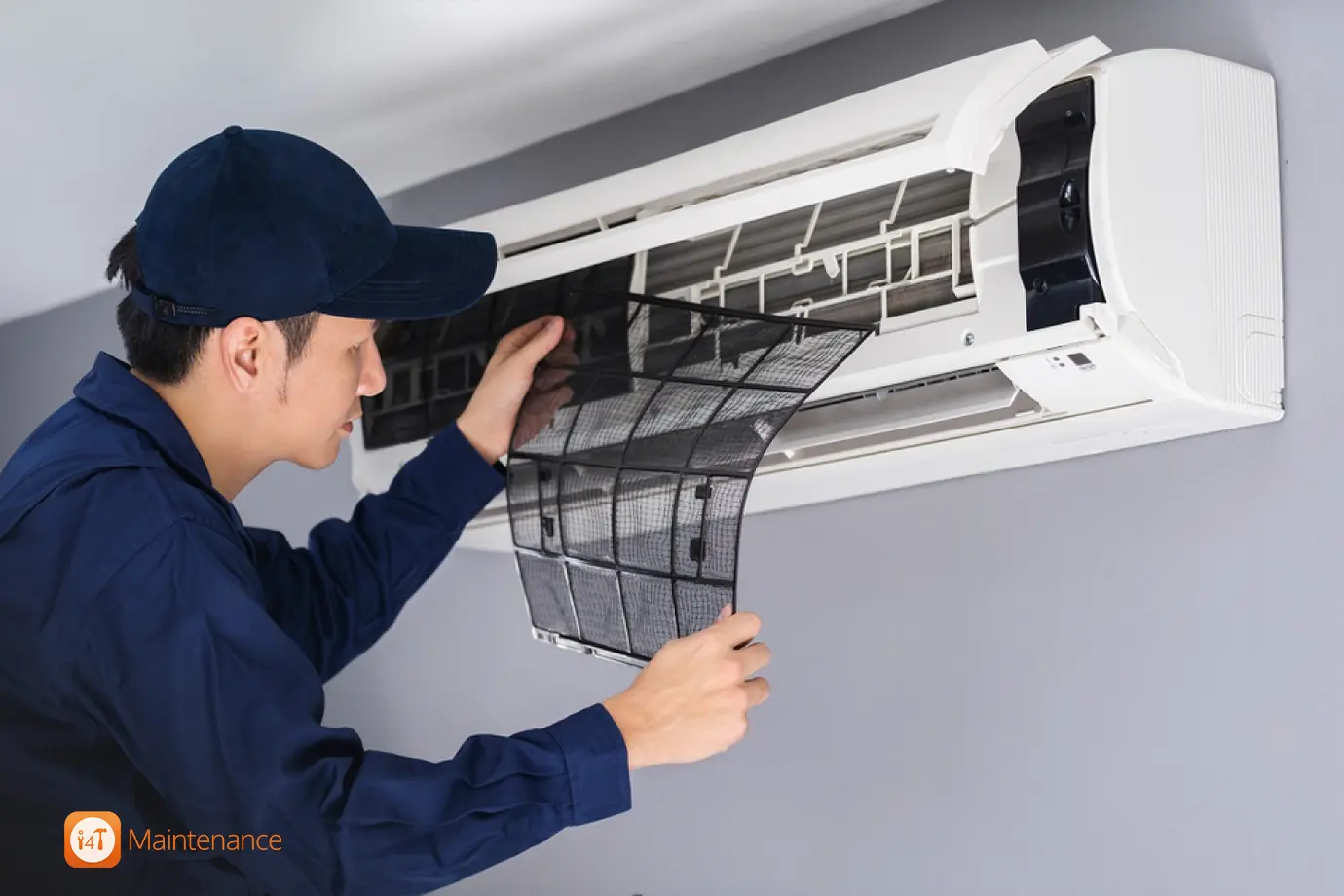Maintenance and repairs are vital activities in property management to keep equipment, facilities, systems, and assets running optimally.
If numbers are any indication highlighting the importance of repairs and maintenance, industries in the U.S. lost approximately 647 billion per year in unplanned downtime and poor maintenance, according to the International Society of Automation.
In this article, we look more closely at what entails maintenance and repairs. We’ll understand what is the difference between the two, what are the various strategies to carry out both activities, and how to make the process more efficient and fool-proof for your business.
What are repairs?
Repair activities include the work carried out to restore the condition of an asset after a failure has already taken place. The reason for this failure could be anything from aging equipment to manhandling, letting too much time go by between scheduled maintenance and something else.
What are common repair categories?
The extent of repair work needed depends on the extent of failure that has occurred. As such, failure has been categorized into partial and complete failure. Hence some repairs might be more expensive to carry out than others.
Partial failure
This is the most common failure type and generally does not happen all of a sudden. A partial failure is when an equipment or system keeps working but is not working as it should.
This means that you can still use the asset, but it may be either unsafe, less efficient, or less effective to use it. For example, you may notice that your air conditioner is not cooling the room as nicely as it was during the first few years after you got the new system installed. Since partial failures do not lead to a complete operational halt, attending to them as soon as they are noticed, can help restore them to their original condition. This makes repair work easier and cheaper.
Complete failure
When complete failure occurs, the asset becomes 100% unavailable for use. No work can be performed using it and it stops to serve its purpose. For example, the air conditioner gives an error when you attempt to turn it on. It won’t turn on and won’t cool the room at all. When equipment or system fails, it results in unplanned downtime and warrants an emergency repair to get it fixed right away. Since the extent of this failure is greater, it might be difficult and costlier to fix it. You might even have to consider the costs of getting it repaired vs replaced if the failure is too bad.
What are the different types of repairs?
As a maintenance manager, it might help to categorize repair types and know what kind of asset failures warrant which repair strategy.
The four types of repairs include:
Emergency repairs
These repairs are carried out when immediate action needs to be taken to make a property, equipment, or system safe and functional again. For example, a burst pipe that may pose the risk of flooding the property warrants an emergency repair.
Emergency repairs need a rapid response and need to be prioritized and communicated well by the maintenance manager.
Scheduled repairs
These repairs are planned based on various factors. This can be an asset’s useful life or something that came up during a routine inspection. An asset’s history of breakdowns can also be used to predict when a repair is needed next and a repair schedule is created accordingly to reduce the impact of disruptions due to repair work being carried out. For example, scheduling the replacement of the worn-out parts of a machine at a time when it’s not being worked on.
Cosmetic repairs
These repairs are carried out to improve the visual appeal or perceived value of an asset for the user. These are not urgent repairs that in any way affect the functionality of the asset or impact user safety. An example includes fixing the peeling paint of a residential building, fixing minor dents in a vehicle, and so on.
Structural repairs
These are critical repairs that if left unprioritized might later on turn into costly replacements and even safety hazards. These involve the restoration of the strength and stability of building structures. Specialized materials are used in the process, reinforcements are done and overall strength is enhanced.
What is maintenance?
Maintenance is the process of taking care of assets to keep them functional and safe. It ensures continuity of operations by minimizing asset downtime.
The primary goal of maintenance is to reduce the need for unplanned repairs.
What are common types of maintenance?

While repairs can be categorized into the types of failures, maintenance on the other hand can be categorized into the types of maintenance strategies you need to consider.
In its most simplistic form, maintenance strategies can be divided into reactive and proactive maintenance:
Reactive maintenance: Reactive maintenance, also known as corrective maintenance or run-to-failure maintenance, is a strategy where you allow the asset to fail before carrying out the maintenance work. In order words, the maintenance work is carried out only as a reaction to a problem.
This kind of maintenance has its drawbacks in terms of asset downtime, disruption to operations, lost revenue, etc, Hence it has largely been replaced by proactive maintenance strategies. Nonetheless, for some assets, the benefits of allowing an asset to run to failure outweigh the costs of carrying out regular maintenance. If such is the case, it can still be a good maintenance strategy. An example includes the replacement of light bulbs only after they have blown out.
Proactive maintenance: Proactive maintenance is any maintenance activity that is carried out to identify the reason and fix it before the issue occurs. It can be further divided into preventive maintenance, condition-based maintenance, predictive maintenance, and prescriptive maintenance.
Preventive maintenance
Preventive maintenance involves regularly carrying out maintenance of equipment, systems, or assets to prevent them from failing. This strategy helps minimize asset downtime while the asset is still operational.
An example of preventive maintenance includes regularly changing the oil of machinery to prevent wear and tear.
Condition-based maintenance
Condition-based maintenance is a strategy in which the actual condition of the asset is analyzed to determine which maintenance strategy is most suitable. This is done by attaching sensors to the asset, which helps detect any changes in the pre-determined base condition from the actual condition. These could be parameters such as equipment vibration, temperature, and electric current. Any such change is then reported through an alert and the maintenance manager creates a work order to get it resolved.
Predictive maintenance
Predictive maintenance takes preventive maintenance a step further and works to predict a failure based on past trends. It uses advanced data analysis tools and techniques to detect anomalies and predict equipment failure before it occurs.
An example of predictive maintenance is the use of vibration analysis to monitor the condition of the equipment and predict when it might begin to show signs of failure.
Prescriptive maintenance
Prescriptive maintenance goes beyond predicting failures and suggests what should be done to extend the equipment’s useful life and prevent it from experiencing any failures at all. Hence it gives a recommendation based on time, cost, and resource availability regarding the best course of action to take.
Repair or Maintenance? Which one should you aim for?

When it comes to creating an effective asset management strategy, the question is not whether you should aim for repair or maintenance. Rather, as a maintenance manager, you should focus on finding the right balance between both.
The case for maintenance
Maintenance, when done regularly and proactively, reduces repair costs, increases assets’ useful life, increases safety and efficiency, and minimizes asset downtime.
When repairs are inevitable
Despite the most vigilant maintenance practices, you still might end up repairing some equipment, systems, or assets in or around your property. This is due to unforeseen breakdowns and external factors that are beyond your control.
When this happens, you need to make sure to provide a quick response to the repair need and ensure a quality service. You should also consider such events as an opportunity to learn why a certain breakdown happened and use those insights to prevent such failures from taking place in the future.
Balancing repairs and maintenance
The best maintenance strategy is a combination of both maintenance and repairs. To achieve this you need to:
- Create a regular maintenance schedule and implement a robust preventive maintenance strategy.
- Have a plan in place to quickly address emergency repair requests.
- Regularly review both strategies, learn from past experiences, and make adjustments to your operations accordingly.
How does maintenance management software help you carry out maintenance and repairs?
Maintenance management software is a powerful tool to enhance the efficiency of your maintenance and repair activities. It can help you
- Quickly respond to repair and maintenance requests.
- Create and assign work orders to credible suppliers.
- Monitor and track progress in real-time.
- Maintain history of work orders and maintenance work.
- Remotely access information from anywhere via mobile.
- Ensure better compliance from start to finish.
- Improve communication between everyone involved.
i4T Maintenance is one such maintenance management platform that allows you to get all of the above benefits and helps you stay on top of your maintenance and repair jobs.
Take the next step. Get started with i4T Maintenance. Book a demo today.
FAQs
Maintenance is about regular actions to keep machines or systems running smoothly and prevent breakdowns. Repairs are what you do when something has already broken down or isn’t working right.
Preventive maintenance is key because it helps avoid machine failures, reduces the time machines are not working, and makes them last longer. It’s about checking and servicing equipment regularly to stop problems before they start.
Predictive maintenance is a way to take care of machines before they break down, using data and tech tools. It involves keeping an eye on things like vibration and temperature to figure out when a machine might need attention.
Good maintenance and quick repairs are essential for smooth business operations, safety, and reliability. Bad maintenance can lead to more machine breakdowns, more downtime, higher repair costs, and even safety hazards. Well-maintained equipment, on the other hand, keeps things running smoothly and can improve a business’s profits.
Some smart strategies include setting up a regular maintenance schedule, using software to track and plan maintenance, training your team well, doing regular checks, and being proactive about maintenance and repairs. Staying updated with new tech and incorporating it into your maintenance plan is also important.
Hot off the press!

With our cutting-edge technology and in-depth knowledge of how the Field Service Management sector operates, the i4TGlobal Team loves to share industry insights to help streamline your business processes and generate new leads. We are driven by innovation and are passionate about delivering solutions that are transparent, compliant, efficient and safe for all stakeholders and across all touch points.




